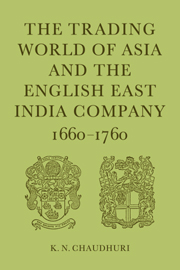Book contents
- Frontmatter
- Contents
- Tables
- Figures
- Maps
- Abbreviations
- Notes on dates, contemporaneous spellings, currency, and weights
- Preface
- Acknowledgements
- 1 The international economy and the East India trade
- 2 A formal theoretical model of the East India Company's trade
- 3 The structure of early trade and the pattern of commercial settlements in Asia
- 4 The evolution of the Company's trading system: operation and policy 1660–1760
- 5 Long-term trends and fluctuations 1660–1760
- 6 Politics of trade
- 7 Markets, merchants, and the Company
- 8 The export of treasure and the monetary system
- 9 The structure of country trade in Asia
- 10 Export of European commodities
- 11 The Company and the Indian textile industry
- 12 The Company's trade in textiles
- 13 Pepper
- 14 Import of bulk goods
- 15 Raw silk
- 16 Coffee
- 17 Imports from China
- 18 Financial results
- 19 Conclusion
- APPENDICES
- General glossary
- Bibliography
- Short titles cited in the reference notes
- Notes
- Index
- Frontmatter
- Contents
- Tables
- Figures
- Maps
- Abbreviations
- Notes on dates, contemporaneous spellings, currency, and weights
- Preface
- Acknowledgements
- 1 The international economy and the East India trade
- 2 A formal theoretical model of the East India Company's trade
- 3 The structure of early trade and the pattern of commercial settlements in Asia
- 4 The evolution of the Company's trading system: operation and policy 1660–1760
- 5 Long-term trends and fluctuations 1660–1760
- 6 Politics of trade
- 7 Markets, merchants, and the Company
- 8 The export of treasure and the monetary system
- 9 The structure of country trade in Asia
- 10 Export of European commodities
- 11 The Company and the Indian textile industry
- 12 The Company's trade in textiles
- 13 Pepper
- 14 Import of bulk goods
- 15 Raw silk
- 16 Coffee
- 17 Imports from China
- 18 Financial results
- 19 Conclusion
- APPENDICES
- General glossary
- Bibliography
- Short titles cited in the reference notes
- Notes
- Index
Summary
General trends and fluctuations in imports: the interaction in supply and demand
Three centuries ago the southern Yemen and small areas of Ethiopia were the only places in the world which supplied the Middle East and Europe with coffee. With the arrival of the Dutch and the English at the port of Mokha and in the Red Sea area generally the coffee trade of the Yemen was to undergo dramatic changes. The tribal rulers of the region were always jealous of any attempts made by foreigners to export seeds and seedlings of the coffee tree and there were stringent regulations against any such attempt, as the servants of the English East India Company often testified. But as the coffee-drinking habit rapidly spread in Europe and other parts of the world during the seventeenth and eighteenth centuries with the consequent rise in demand, the monopoly enjoyed by the coffee growing areas of the Red Sea was to be broken for ever, and its cultivation extended to Ceylon, Java, the Caribbean and South America. Another unlooked-for consequence was the greater availability of documentation on the volume and structure of trade, which the purely Islamic sources of the time seem to lack. The descriptions left behind by European travellers and merchants, and the records of the English and Dutch East India Companies provide not only vivid accounts of the trading conditions at Mokha and Beit el-Fakih, the chief centres of coffee trade, but also detailed information on the exports of various nations, prices, methods of purchase, commercial regulations, the areas of coffee growth and system of cultivation, and finally the economics of marketing.
- Type
- Chapter
- Information
- The Trading World of Asia and the English East India Company1660-1760, pp. 359 - 384Publisher: Cambridge University PressPrint publication year: 1978

